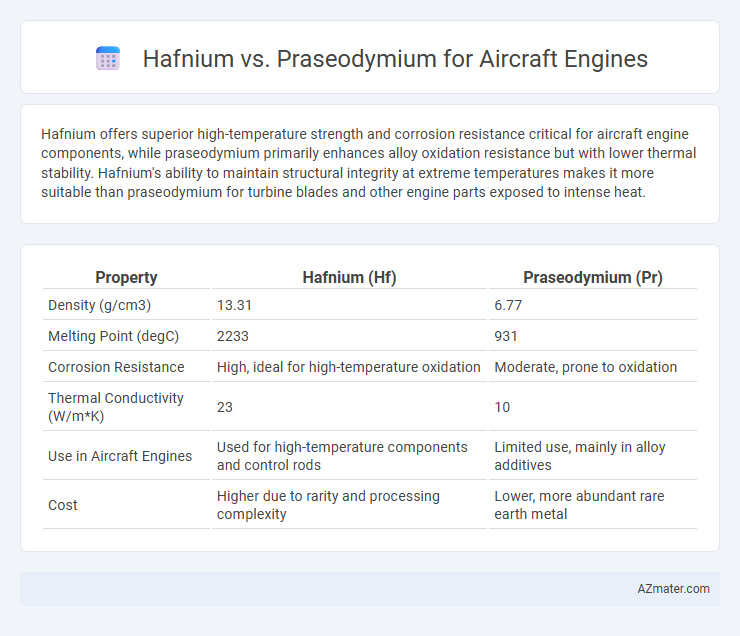Hafnium offers superior high-temperature strength and corrosion resistance critical for aircraft engine components, while praseodymium primarily enhances alloy oxidation resistance but with lower thermal stability. Hafnium's ability to maintain structural integrity at extreme temperatures makes it more suitable than praseodymium for turbine blades and other engine parts exposed to intense heat.
Table of Comparison
| Property | Hafnium (Hf) | Praseodymium (Pr) |
|---|---|---|
| Density (g/cm3) | 13.31 | 6.77 |
| Melting Point (degC) | 2233 | 931 |
| Corrosion Resistance | High, ideal for high-temperature oxidation | Moderate, prone to oxidation |
| Thermal Conductivity (W/m*K) | 23 | 10 |
| Use in Aircraft Engines | Used for high-temperature components and control rods | Limited use, mainly in alloy additives |
| Cost | Higher due to rarity and processing complexity | Lower, more abundant rare earth metal |
Introduction to Hafnium and Praseodymium in Aerospace
Hafnium exhibits exceptional high-temperature stability and corrosion resistance, making it a critical element in aircraft engine components subjected to extreme thermal environments. Praseodymium offers valuable magnetic and alloying properties but is less prominent in aerospace applications compared to Hafnium's role in enhancing turbine blade durability. The unique refractory characteristics of Hafnium contribute significantly to improved engine performance and longevity in modern aerospace engineering.
Chemical and Physical Properties Comparison
Hafnium, with an atomic number of 72 and a melting point of 2233degC, exhibits excellent high-temperature stability and corrosion resistance, making it ideal for aircraft engine components exposed to extreme conditions. Praseodymium, atomic number 59, has a lower melting point of 931degC and is less corrosion-resistant but offers significant magnetic and electrical properties beneficial for specialized engine sensors and magnetic applications. The denser atomic structure and superior thermal endurance of hafnium contribute to enhanced engine durability and performance under high-stress operating environments compared to praseodymium.
Thermal Stability and High-Temperature Performance
Hafnium exhibits superior thermal stability and high-temperature oxidation resistance compared to praseodymium, making it more suitable for aircraft engine components exposed to extreme heat. Its melting point of 2233degC and ability to maintain mechanical strength at elevated temperatures enable better performance in turbine blades and combustion chambers. Praseodymium, while useful in certain alloys for corrosion resistance, lacks the high-temperature endurance critical for sustained engine operation under thermal stress.
Corrosion Resistance and Oxidation Behavior
Hafnium exhibits superior corrosion resistance and oxidation stability at high temperatures compared to praseodymium, making it more suitable for aircraft engine applications exposed to extreme environments. Hafnium oxide forms a dense, adherent protective layer that effectively prevents further oxidation and degradation, whereas praseodymium tends to form less stable oxide scales prone to spallation. The enhanced performance of hafnium alloys in resisting high-temperature corrosion directly contributes to improved engine durability and reliability.
Role in Turbine Blade Manufacturing
Hafnium enhances turbine blade manufacturing through its exceptional high-temperature strength and corrosion resistance, making it critical for thermal barrier coatings in aircraft engines. Praseodymium, while primarily valued for improving magnetic and optical properties, plays a lesser role in turbine blade durability and heat resistance. The incorporation of hafnium alloys significantly extends turbine blade lifespan and efficiency under extreme operating conditions.
Mechanical Strength and Alloyability
Hafnium exhibits superior mechanical strength and high-temperature stability, making it ideal for aircraft engine components subject to extreme thermal and mechanical stress. Its excellent alloyability with refractory metals enhances its performance in critical turbine parts by improving creep resistance and oxidation stability. Praseodymium, while useful for improving magnetic properties and corrosion resistance, lacks the mechanical strength and high-temperature alloying benefits necessary for demanding aerospace engine applications.
Weight Considerations in Engine Design
Hafnium offers high density and excellent thermal resistance, which enhances durability but increases the overall weight of aircraft engines. Praseodymium, being lighter with good oxidation resistance, contributes to weight reduction and improved fuel efficiency in engine design. Balancing hafnium's strength with praseodymium's lower weight is crucial for optimizing performance while minimizing aircraft engine mass.
Cost and Rarity in Global Supply Chains
Hafnium and Praseodymium both play roles in advanced aircraft engine components, but Hafnium is significantly rarer and more costly due to its limited global supply primarily sourced from a few mining regions, such as Australia and South Africa. Praseodymium, more abundant and mined extensively in China, offers a comparatively lower cost and greater availability, making it a more economically feasible option for manufacturers. The constrained supply and high extraction costs of Hafnium result in price volatility, which poses challenges for aircraft engine production reliant on stable material sourcing.
Environmental and Safety Impacts
Hafnium's exceptional high-temperature stability and corrosion resistance make it highly suitable for aircraft engine components, reducing the risk of material degradation and enhancing operational safety. Praseodymium, while beneficial for its magnetic and optical properties, offers less thermal resilience, potentially leading to faster wear and increased environmental emissions due to more frequent maintenance needs. The use of hafnium alloys in aircraft engines contributes to lower pollutant output through improved efficiency and decreased risk of catastrophic failures, supporting stricter environmental regulations and safety standards.
Future Trends for Hafnium and Praseodymium in Aircraft Engines
Hafnium's excellent high-temperature stability and corrosion resistance make it a promising material for advanced turbine blades and thermal barrier coatings in next-generation aircraft engines, supporting enhanced fuel efficiency and engine longevity. Praseodymium, valued for its lightweight properties and excellent magnetic and thermal characteristics, is increasingly considered for use in engine control systems and electric motor components, aligning with the rise of hybrid-electric propulsion technologies. Future trends emphasize the integration of hafnium alloys in ultra-high-temperature ceramics and the development of praseodymium-doped materials for improved electrical performance in smart engine systems.

Infographic: Hafnium vs Praseodymium for Aircraft Engine
 azmater.com
azmater.com